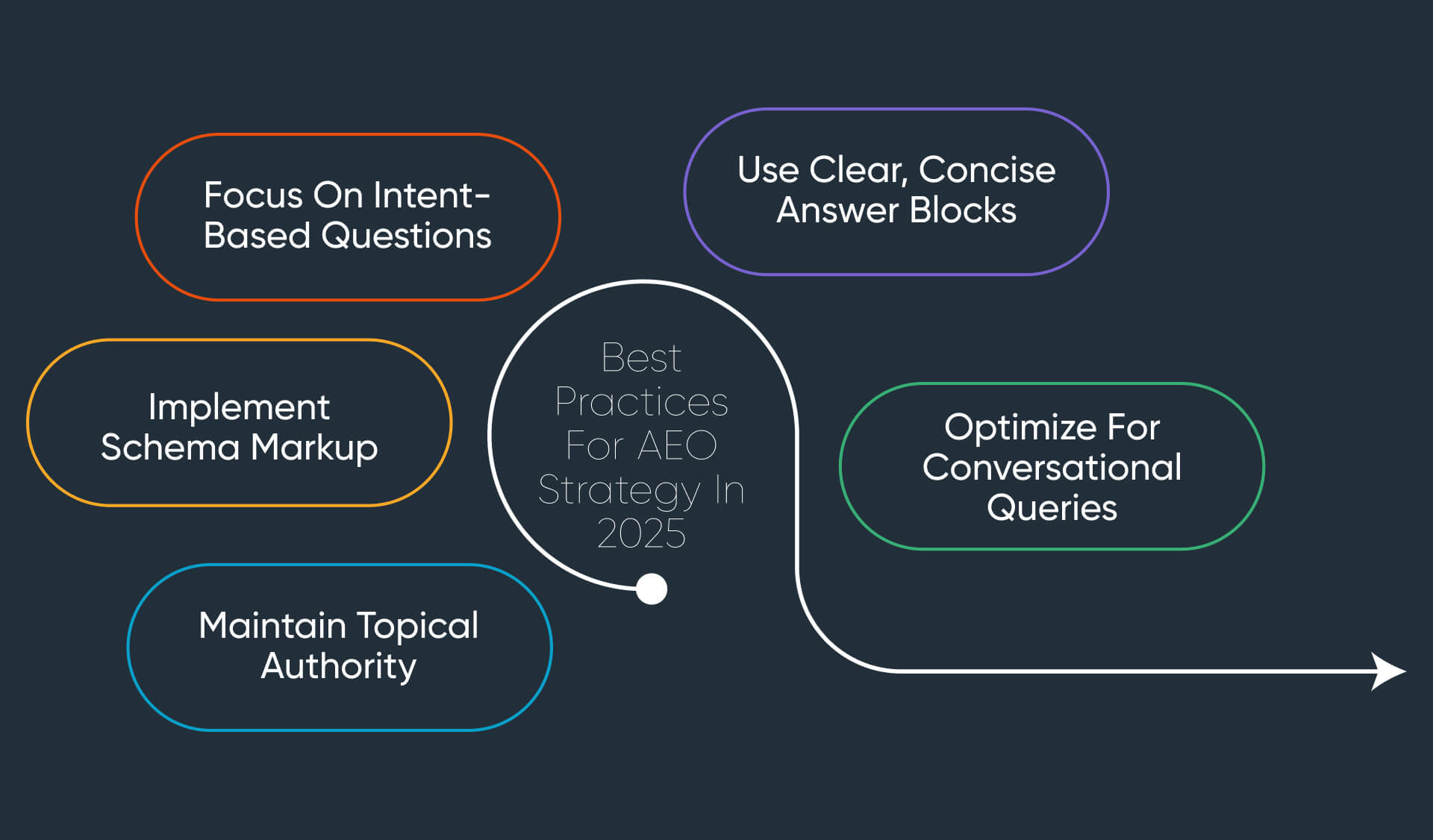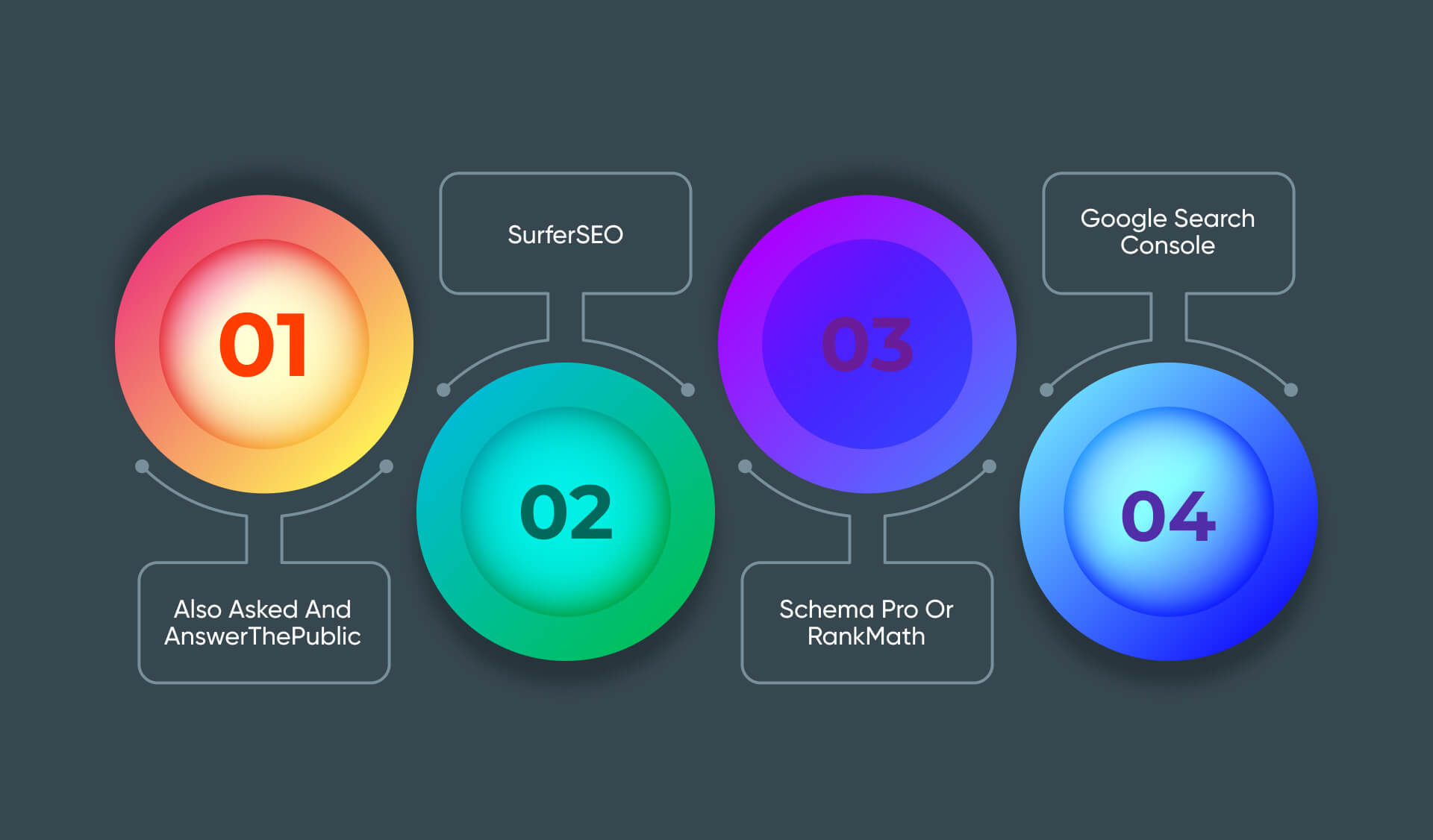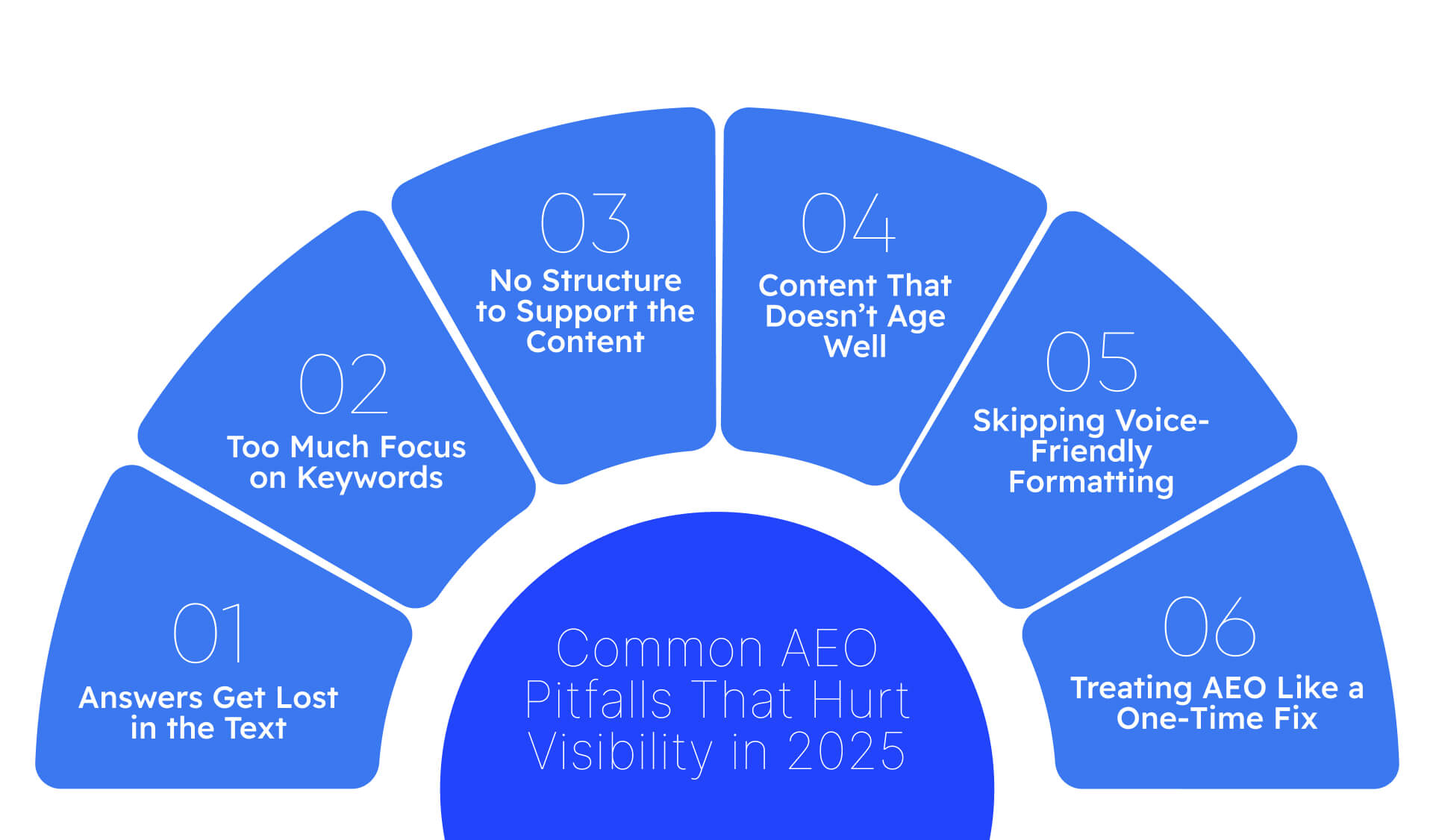Mastering AEO Strategy 2025 Best Practices That Work

 10.5 min
10.5 min
Search behavior is evolving faster than most businesses realize. It’s no longer just about appearing on search engine results pages; it’s about delivering precise answers in real time. Whether through Google’s featured snippets, voice assistants, or AI-driven chat interfaces, today’s digital audience expects clarity, speed, and trust.
In 2025, businesses that aim to stay visible online are shifting their focus toward something more refined than traditional SEO. Enter: answer engine optimization AEO strategy 2025 best practices. A direction that prioritizes direct, structured, and contextual answers over keyword stuffing and backlink chasing.
This shift isn’t a temporary trend. It’s a foundational change in how visibility works in a world where AI interprets questions, not just queries. And for brands serious about being found in 2025 and beyond, it’s time to master this strategy before the competition does. For businesses aiming to stay visible, especially through platforms like ChatGPT, Google’s SGE, or voice search, understanding the AEO optimization best practices is essential.
Want to Master AEO Strategy 2025 Fast?
Discover practical AEO strategies backed by results. This isn’t theory it’s how smart brands are actually ranking in 2025.
Get Your AEO Strategy Blueprint
Answer Engine Optimization AEO Strategy 2025 Best Practices

Implementing AEO isn’t about adding a few FAQ sections and walking away. It requires a focused strategy built on how modern AI systems process, evaluate, and surface content.
Here are some AEO optimization best practices every brand should consider in 2025:
1. Structure Your Content for AI
Use schema markup, headings, and bullet points. Structured data helps answer engines extract the most relevant parts of your content. It’s not just good for visibility, it’s essential.
2. Write in a Q&A Format
Modern search queries often come in the form of questions. A well-written question followed by a crisp answer is a core part of AEO best practices today.
3. Focus on Authoritativeness
AI systems prioritize trustworthy sources. This means accurate data, expert tone, and regularly updated content. Being helpful, not just visible, matters more than ever.
4. Keep Answers Brief and Clear
Long paragraphs confuse answer engines. Instead, craft short, direct answers. This simplicity helps in both featured snippets and AI-powered responses.
5. Refresh Content Regularly
AI systems value updated, current data. That’s why revisiting existing posts and applying updated AEO optimization best practices is one of the smartest moves brands can make in 2025.
In fact, many businesses partner with an organic SEO company to ensure that AEO practices are built on a solid foundation of technical SEO and evergreen content. This pairing supports both traditional visibility and AI-readiness.
What is Answer Engine Optimization (AEO)?
Answer Engine Optimization, or AEO, refers to the process of making digital content easily digestible and accessible for AI-driven engines that deliver direct answers like Google’s featured snippets, Bing AI, and even tools like ChatGPT or Perplexity.
Where traditional SEO often focuses on optimizing for a set of keywords, AEO is about optimizing for questions the ones real people ask every day. It involves structuring content in ways that make it easy for search engines and AI to extract clear, credible answers from a page.
By aligning with answer engine optimization AEO strategy 2025 best practices, brands position themselves not just to rank but to lead the conversation.
Is Your AEO Optimization Future-Ready Yet?
The 2025 algorithms demand more than keywords. Fill the form and get exclusive insights on building AEO content that survives algorithm shifts.
Future-Proof My AEO Approach
Why AEO Matters in 2025
The way audiences discover information is changing dramatically. AI tools and smart assistants are pushing users away from scanning multiple pages they want fast, trusted, direct answers. This shift gives rise to a new digital battleground: who answers the question best?
In 2025, it's not just about who shows up it’s about who gets featured. Businesses that fail to implement Answer Engine Optimization AEO strategy 2025 best practices are missing out on an opportunity to own that space.
AEO bridges the gap between high-value content and real-time answers. It’s no longer enough to rank on page one. If a brand isn’t the direct answer, it’s likely not being noticed at all.
Key Differences Between AEO and Traditional SEO
Understanding the difference is essential for brands looking to adapt early. Implementing the answer engine optimization AEO strategy 2025 best practices isn’t just about traffic; it’s about building authority, delivering clarity, and ensuring that responses are fast, relevant, and reliable across all search experiences. While SEO and AEO may sound similar, their priorities differ in subtle but important ways.
| Aspect | Traditional SEO | Answer Engine Optimization (AEO) |
| Focus | Keywords & Rankings | Questions & Direct Answers |
| Format | Long-form, often unstructured | Structured, scannable, contextual |
| Goal | Rank pages in search results | Get featured in answer boxes or AI responses |
| Tools | Backlinks, metadata, keyword tools | Schema markup, NLP, structured Q&A |
Implementing answer engine optimization AEO strategy 2025 best practices means thinking beyond traffic and focusing on authority, clarity, and response time.
Struggling to Rank on AI Overview Panels?
If your content isn’t showing up in AI-powered search answers, something’s off. Let’s fix that with a personalized AEO audit.
Request A Free AEO Audit
Best Practices for AEO Strategy in 2025

Success with AEO depends on understanding what engines are looking for and delivering it in a user-first format. The following best practices shape a strong foundation for visibility in 2025:
Focus on Intent-Based Questions
Identify the questions that target audiences are actually asking. Tools like AnswerThePublic and Google’s “People Also Ask” can uncover real search behavior.
Use Clear, Concise Answer Blocks
Summarize answers in 40–60 words before elaborating. This boosts chances of being selected for featured snippets or voice results.
Implement Schema Markup
Structured data helps search engines understand what content is about. FAQ, HowTo, and Q&A schema are particularly powerful.
Optimize for Conversational Queries
AI engines thrive on natural language. Content that mirrors how questions are actually spoken performs better.
Maintain Topical Authority
Instead of covering a single keyword, build clusters around related questions. This builds trust with engines and readers alike.
Each of these is rooted in answer engine optimization AEO strategy 2025 best practices — and together, they shape visibility in the AI-first internet.
How to Structure Content for AEO Success
Great answers need more than knowledge; they need structure. AEO-ready content follows a format that AI can parse instantly.
Here’s how leading brands are building their content:
- Start with a clear question: Make sure it mirrors actual search queries.
- Answer immediately: No fluff, deliver the response upfront.
- Provide supporting detail: Expand on the answer with relevant context or examples.
- Use headers and bullet points: These break down information for both humans and machines.
- Include structured FAQ sections: These serve as direct entry points for AI engines.
Structuring pages using answer engine optimization AEO strategy 2025 best practices allows content to live not just on a webpage, but across AI tools, voice searches, and chat interfaces.
Ready to Dominate With AEO in 2025?
The rules of SEO have changed. AEO is the new playing field. Learn how to make your brand visible where it matters.
Access AEO Success Kit
Tools and Technologies Powering AEO in 2025

Today’s AEO strategies aren’t driven by guesswork. A range of powerful tools supports every stage of optimization from identifying user questions to formatting content for extraction.
Also Asked and AnswerThePublic: Reveal how real users phrase their questions.
- SurferSEO: Helps fine-tune content length, structure, and NLP matching.
- Schema Pro or RankMath: Adds structured data to WordPress or other CMS platforms.
- Google Search Console: Tracks performance of featured snippets and question-based keywords.
Combining these tools with a clear content strategy based on answer engine optimization AEO strategy 2025 best practices ensures brands stay one step ahead of evolving search behaviors.
Common Mistakes to Avoid in AEO
AEO may be powerful, but it’s also precise. Missing the mark often leads to lost opportunities. Here are some pitfalls businesses must avoid:
- Overloading with keywords: This dilutes answer clarity and reduces credibility.
- Ignoring schema markup: Without it, engines struggle to interpret context.
- Burying answers in dense paragraphs: AI tools skip over unclear content.
- Treating AEO as a one-time fix: Continuous updates are essential as engines evolve.
- Forgetting voice search readiness: If it can’t be spoken naturally, it won’t perform well in 2025’s ecosystem.
Every successful brand following the answer engine optimization AEO strategy 2025 best practices knows the importance of adapting not just the content but the mindset behind it.
Want Your Content Featured in AI Snapshots?
Get the insider strategy to land your brand in AI-generated summaries and overviews. Trusted by marketers across industries.
Claim My Spot in AI Overviews
Common AEO Pitfalls That Hurt Visibility in 2025

Not all AEO efforts hit the mark. Even with the best intentions, certain mistakes can quietly chip away at visibility, especially in a digital space where AI tools decide what gets seen. In 2025, being the answer means getting the details right.
Here are a few areas where things often go wrong:
1. Answers Get Lost in the Text
A page may be full of great information, but if the actual answer is buried halfway down in a dense paragraph, AI isn’t going to wait around. What works better is placing the core response right near the top, clean, simple, and to the point.
2. Too Much Focus on Keywords
Old SEO habits can be hard to break. Overloading content with keywords tends to make the language stiff and unnatural. Today’s AI prefers a tone that sounds like something a person would actually say, not something designed to impress an algorithm.
3. No Structure to Support the Content
Without proper headers, bullets, or schema markup, even the best-written pages can underperform. AI tools rely on structure to figure out what matters and where it is on the page. Missing those signals means missed chances to show up in search.
4. Content That Doesn’t Age Well
Outdated details, broken links, or stats from three years ago can hurt credibility. AEO rewards fresh, reliable content especially when the information being shared answers timely or evergreen questions.
5. Skipping Voice-Friendly Formatting
If a page sounds awkward when read aloud, it likely won’t show up in voice results. The best-performing AEO content feels natural when spoken in short sentences, clear phrasing, and no jargon-heavy explanations.
6. Treating AEO Like a One-Time Fix
AEO isn’t something to tick off once and forget. AI engines keep learning, and user behavior keeps shifting. That means content has to keep evolving, too. The brands that show up consistently are the ones that treat optimization as an ongoing process.
Avoiding these pitfalls is just as important as following best practices. The brands that succeed with answer engine optimization AEO strategy 2025 best practices don’t just write for search; they build for clarity, context, and long-term discoverability.
How Edifying Voyages Supports AEO Strategy
In a world shifting toward instant, AI-powered answers, content alone isn’t enough. It must be optimized, structured, and engineered for discoverability. That’s where strategic partners like Edifying Voyages make the difference. Partnering with a local SEO agency can help businesses tailor their AEO strategy for regional keywords and hyper-localized intent, giving them a unique advantage in both traditional and AI-first search spaces.
From building structured content ecosystems to implementing schema-rich frameworks, Edifying Voyages helps brands transition from basic SEO to future-ready AEO, with the help of the best answer engine optimization services. The team doesn’t just optimize content; it helps build digital trust in a world where AI is the gatekeeper.
For businesses seeking to master answer engine optimization AEO strategy 2025 best practices, the difference lies in having the right systems and the right support.
Think Traditional SEO Alone Is Enough in 2025?
Think again. AEO is already reshaping search. Fill out the form to stay ahead of this shift before your competitors do.
Secure My AEO Edge
Conclusion
The landscape of search has changed. It’s no longer about visibility alone; it’s about authority, trust, and being the definitive answer when it matters most.
By embracing answer engine optimization AEO strategy 2025 best practices, brands take a bold step into the future of search, one that’s led by AI, powered by structure, and driven by clarity.
Partnering with a forward-thinking offshore SEO agency like Edifying Voyages ensures that every piece of content serves a purpose not just to rank, but to answer. And in 2025, that’s what sets leading brands apart.
FAQs
Traditional SEO focuses on ranking pages using keywords and backlinks. AEO, or Answer Engine Optimization, is about giving clear, direct answers to specific user questions. It’s designed for AI tools, voice assistants, and featured snippets.
Start by researching common user queries related to the topic. Structure content in a question-and-answer format with clear, concise responses. Use schema markup to help search engines better understand the context.
Tools like AnswerThePublic and AlsoAsked help find real user questions. Platforms like SEMrush, Surfer SEO, and schema generators support optimization. These help structure content to match what answer engines are looking for.
Yes, because voice assistants rely on direct, conversational answers. AEO structures content in a way that fits voice queries naturally. It improves the chances of being the spoken result in voice search.
Ideally, review AEO content every three to six months. Update based on changing search trends, questions, or algorithm shifts. Keeping it fresh helps maintain visibility in evolving answer engines.




